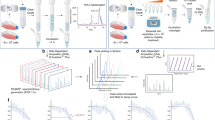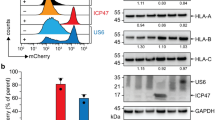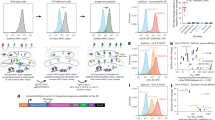Abstract
Vaccines and immunotherapies that target peptide–major histocompatibility complexes (peptide–MHCs) have the potential to address multiple unmet medical needs in cancer and infectious disease. Designing vaccines and immunotherapies to target peptide–MHCs requires accurate identification of target peptides in infected or cancerous cells or tissue, and may require absolute or relative quantification to identify abundant targets and measure changes in presentation under different treatment conditions. Internal standard parallel reaction monitoring (also known as ‘SureQuant’) can be used to validate and/or quantify MHC peptides previously identified by using untargeted methods such as data-dependent acquisition. SureQuant MHC has three main use cases: (i) conclusive confirmation of the identities of putative MHC peptides via comparison with an internal synthetic stable isotope labeled (SIL) peptide standard; (ii) accurate relative quantification by using pre-formed heavy isotope-labeled peptide–MHC complexes (hipMHCs) containing SIL peptides as internal controls for technical variation; and (iii) absolute quantification of each target peptide by using different amounts of hipMHCs loaded with synthetic peptides containing one, two or three SIL amino acids to provide an internal standard curve. Absolute quantification can help determine whether the abundance of a peptide–MHC is sufficient for certain therapeutic modalities. SureQuant MHC therefore provides unique advantages for immunologists seeking to confidently validate antigenic targets and understand the dynamics of the MHC repertoire. After synthetic standards are ordered (3–4 weeks), this protocol can be carried out in 3–4 days and is suitable for individuals with mass spectrometry experience who are comfortable with customizing instrument methods.
key points
-
Target peptides presented on MHCs can be detected by using data-dependent mass spectrometry methods, but their presence needs to be validated and quantified to develop vaccines and immunotherapies to target peptide–MHCs.
-
SureQuant is a class of mass spectrometry methods in which parallel reaction monitoring is triggered by the detection of known stable isotope-labeled standards. Standards are prepared on the basis of the DDA findings and used in this MHC SureQuant protocol.
This is a preview of subscription content, access via your institution
Access options
Access Nature and 54 other Nature Portfolio journals
Get Nature+, our best-value online-access subscription
$32.99 / 30 days
cancel any time
Subscribe to this journal
Receive 12 print issues and online access
$259.00 per year
only $21.58 per issue
Buy this article
- Purchase on SpringerLink
- Instant access to full article PDF
Prices may be subject to local taxes which are calculated during checkout






Similar content being viewed by others
Data availability
Raw mass spectrometry data used in Fig. 4 are part of a dataset deposited to the PRIDE database with the dataset identifier PXD03784328,62. Skyline reports containing quantification information used in Figs. 5 and 6 are included in our GitHub repository at https://github.com/oleddy/SureQuant_MHC/ and in Supplementary Information, Software 2.
Code availability
All code is available at https://github.com/oleddy/SureQuant_MHC/ and provided in Supplementary Information, Software 2.
References
Massarelli, E. et al. Combining immune checkpoint blockade and tumor-specific vaccine for patients with incurable human papillomavirus 16–related cancer. JAMA Oncol. 5, 67–73 (2019).
Weber, J. S. et al. Individualised neoantigen therapy mRNA-4157 (V940) plus pembrolizumab versus pembrolizumab monotherapy in resected melanoma (KEYNOTE-942): a randomised, phase 2b study. Lancet 403, 632–644 (2024).
Sette, A., Sidney, J. & Crotty, S. T cell responses to SARS-CoV-2. Annu. Rev. Immunol. 41, 343–73 (2023).
Bettencourt, P. et al. Identification of antigens presented by MHC for vaccines against tuberculosis. NPJ Vaccines 5, 2 (2020).
Karunakaran, K. P. et al. Immunoproteomic discovery of novel T cell antigens from the obligate intracellular pathogen Chlamydia. J. Immunol. 180, 2459–2465 (2008).
Mayer, R. L. et al. Immunopeptidomics-based design of mRNA vaccine formulations against Listeria monocytogenes. Nat. Commun. 13, 6075 (2022).
Stopfer, L. E. et al. MEK inhibition enhances presentation of targetable MHC-I tumor antigens in mutant melanomas. Proc. Natl Acad. Sci. USA 119, e2208900119 (2022).
Jaeger, A. M. et al. Deciphering the immunopeptidome in vivo reveals new tumour antigens. Nature 607, 149–155 (2022).
Hunt, D. F. et al. Characterization of peptides bound to the class I MHC molecule HLA-A2.1 by mass spectrometry. Science 255, 1261–1263 (1992).
Hunt, D. F. et al. Peptides presented to the immune system by the murine class II major histocompatibility complex molecule I-Ad. Science 256, 1817–1820 (1992).
Hunt, D. et al. In Methods in Protein Sequence Analysis (eds Imahori, K. & Sakiyama, F.) 127–133 (Springer, 1993).
Stopfer, L. E., Mesfin, J. M., Joughin, B. A., Lauffenburger, D. A. & White, F. M. Multiplexed relative and absolute quantitative immunopeptidomics reveals MHC I repertoire alterations induced by CDK4/6 inhibition. Nat. Commun. 11, 2760 (2020).
Chong, C., Coukos, G. & Bassani-Sternberg, M. Identification of tumor antigens with immunopeptidomics. Nat. Biotechnol. 40, 175–188 (2022).
Arieta, C. M. et al. The T-cell-directed vaccine BNT162b4 encoding conserved non-spike antigens protects animals from severe SARS-CoV-2 infection. Cell 186, 2392–2409.e21 (2023).
Mohsen, M. O. et al. Bedside formulation of a personalized multi-neoantigen vaccine against mammary carcinoma. J. Immunother. Cancer 10, e002927 (2022).
Sellars, M. C., Wu, C. J. & Fritsch, E. F. Cancer vaccines: building a bridge over troubled waters. Cell 185, 2770–2788 (2022).
Sahin, U. et al. Personalized RNA mutanome vaccines mobilize poly-specific therapeutic immunity against cancer. Nature 547, 222–226 (2017).
Abelin, J. G. et al. Mass spectrometry profiling of HLA-associated peptidomes in mono-allelic cells enables more accurate epitope prediction. Immunity 46, 315–326 (2017).
Sarkizova, S. et al. A large peptidome dataset improves HLA class I epitope prediction across most of the human population. Nat. Biotechnol. 38, 199–209 (2020).
Abelin, J. G. et al. Defining HLA-II ligand processing and binding rules with mass spectrometry enhances cancer epitope prediction. Immunity 51, 766–779.e17 (2019).
Creech, A. L. et al. The role of mass spectrometry and proteogenomics in the advancement of HLA epitope prediction. Proteomics 18, e1700259 (2018).
Gallien, S., Kim, S. Y. & Domon, B. Large-scale targeted proteomics using internal standard triggered-parallel reaction monitoring (IS-PRM). Mol. Cell. Proteom. 14, 1630–1644 (2015).
Hassan, C. et al. Accurate quantitation of MHC-bound peptides by application of isotopically labeled peptide MHC complexes. J. Proteom. 109, 240–244 (2014).
Stopfer, L. E. et al. Absolute quantification of tumor antigens using embedded MHC-I isotopologue calibrants. Proc. Natl Acad. Sci. USA 118, e2111173118 (2021).
Rodenko, B. et al. Generation of peptide–MHC class I complexes through UV-mediated ligand exchange. Nat. Protoc. 1, 1120–1132 (2006).
Faridi, P., Purcell, A. W. & Croft, N. P. In immunopeptidomics we need a sniper instead of a shotgun. Proteomics 18, e1700464 (2018).
Li, K., Jain, A., Malovannaya, A., Wen, B. & Zhang, B. DeepRescore: leveraging deep learning to improve peptide identification in immunopeptidomics. Proteomics 20, e1900334 (2020).
Leddy, O., White, F. M. & Bryson, B. D. Immunopeptidomics reveals determinants of Mycobacterium tuberculosis antigen presentation on MHC class I. eLife 12, e84070 (2023).
Lichti, C. F., Vigneron, N., Clauser, K. R., Van Den Eynde, B. J. & Bassani-Sternberg, M. Navigating critical challenges associated with immunopeptidomics-based detection of proteasomal spliced peptide candidates. Cancer Immunol. Res. 10, 275–284 (2022).
Kacen, A. et al. Post-translational modifications reshape the antigenic landscape of the MHC I immunopeptidome in tumors. Nat. Biotechnol. 41, 239–251 (2023).
Prensner, J. R. et al. What can Ribo-Seq, immunopeptidomics, and proteomics tell us about the noncanonical proteome? Mol. Cell. Proteom. 22, 100631 (2023).
Gessulat, S. et al. Prosit: proteome-wide prediction of peptide tandem mass spectra by deep learning. Nat. Methods 16, 509–518 (2019).
Zolg, D. P. et al. INFERYS rescoring: boosting peptide identifications and scoring confidence of database search results. Rapid Commun. Mass Spectrom. https://doi.org/10.1002/rcm.9128 (2021).
Jaeger, A. M. et al. Rebalancing protein homeostasis enhances tumor antigen presentation. Clin. Cancer Res. 25, 6392–6405 (2019).
Lowe, D. B. et al. TCR-like antibody drug conjugates mediate killing of tumor cells with low peptide/HLA targets. mAbs 9, 603–614 (2017).
Ow, S. Y. et al. iTRAQ underestimation in simple and complex mixtures: “the good, the bad and the ugly”. J. Proteome Res. 8, 5347–5355 (2009).
Savitski, M. M. et al. Measuring and managing ratio compression for accurate iTRAQ/TMT quantification. J. Proteome Res. 12, 3586–3598 (2013).
Aggarwal, S., Talukdar, N. C. & Yadav, A. K. Advances in higher order multiplexing techniques in proteomics. J. Proteome Res. 18, 2360–2369 (2019).
Stone, J. D., Aggen, D. H., Schietinger, A., Schreiber, H. & Kranz, D. M. A sensitivity scale for targeting T cells with chimeric antigen receptors (CARs) and bispecific T-cell Engagers (BiTEs). Oncoimmunology 1, 863–873 (2012).
Ankney, J. A., Muneer, A. & Chen, X. Relative and absolute quantitation in mass spectrometry–based proteomics. Annu. Rev. Anal. Chem. 11, 49–77 (2018).
Curran, T. G., Zhang, Y., Ma, D. J., Sarkaria, J. N. & White, F. M. MARQUIS: a multiplex method for absolute quantification of peptides and posttranslational modifications. Nat. Commun. 6, 5924 (2015).
Kettenbach, A. N., Rush, J. & Gerber, S. A. Absolute quantification of protein and post-translational modification abundance with stable isotope–labeled synthetic peptides. Nat. Protoc. 6, 175–186 (2011).
Stopfer, L. E., D’Souza, A. D. & White, F. M. 1,2,3, MHC: a review of mass-spectrometry-based immunopeptidomics methods for relative and absolute quantification of pMHCs. Immunooncol. Technol. 11, 100042 (2021).
García-Santamarina, S. et al. Monitoring in vivo reversible cysteine oxidation in proteins using ICAT and mass spectrometry. Nat. Protoc. 9, 1131–1145 (2014).
Wang, Z., Rejtar, T., Zhou, Z. S. & Karger, B. L. Desulfurization of cysteine‐containing peptides resulting from sample preparation for protein characterization by mass spectrometry. Rapid Commun. Mass Spectrom. 24, 267–275 (2010).
Denkberg, G., Cohen, C. J., Segal, D., Kirkin, A. F. & Reiter, Y. Recombinant human single-chain MHC-peptide complexes made from E. coli by in vitro refolding: functional single-chain MHC-peptide complexes and tetramers with tumor associated antigens. Eur. J. Immunol. 30, 3522–3532 (2000).
Stopfer, L. E. et al. High-density, targeted monitoring of tyrosine phosphorylation reveals activated signaling networks in human tumors. Cancer Res. 81, 2495–2509 (2021).
Kennedy, J. J. et al. Internal standard triggered-parallel reaction monitoring mass spectrometry enables multiplexed quantification of candidate biomarkers in plasma. Anal. Chem. 94, 9540–9547 (2022).
Croft, N. P. et al. Kinetics of antigen expression and epitope presentation during virus infection. PLoS Pathog. 9, e1003129 (2013).
Sewell, A. K. Why must T cells be cross-reactive? Nat. Rev. Immunol. 12, 669–677 (2012).
Purcell, A. W., Ramarathinam, S. H. & Ternette, N. Mass spectrometry–based identification of MHC-bound peptides for immunopeptidomics. Nat. Protoc. 14, 1687–1707 (2019).
MacLean, B. et al. Skyline: an open source document editor for creating and analyzing targeted proteomics experiments. Bioinformatics 26, 966–968 (2010).
Pino, L. K. et al. The Skyline ecosystem: informatics for quantitative mass spectrometry proteomics. Mass Spectrom. Rev. 39, 229–244 (2020).
The UniProt Consortium. UniProt: the Universal Protein Knowledgebase in 2023. Nucleic Acids Res. 51, D523–D531 (2023).
Behrendt, R., White, P. & Offer, J. Advances in Fmoc solid‐phase peptide synthesis. J. Pept. Sci. 22, 4–27 (2016).
Coin, I., Beyermann, M. & Bienert, M. Solid-phase peptide synthesis: from standard procedures to the synthesis of difficult sequences. Nat. Protoc. 2, 3247–3256 (2007).
Smith, P. K. et al. Measurement of protein using bicinchoninic acid. Anal. Biochem. 150, 76–85 (1985).
Walker, J. M. In The Protein Protocols Handbook 3rd edn (ed. Walker, J. M.) 11–15 (2009).
Makarov, A. et al. Performance evaluation of a hybrid linear ion trap/orbitrap mass spectrometer. Anal. Chem. 78, 2113–2120 (2006).
Brosch, M., Yu, L., Hubbard, T. & Choudhary, J. Accurate and sensitive peptide identification with Mascot Percolator. J. Proteome Res. 8, 3176–3181 (2009).
Andreatta, M., Alvarez, B. & Nielsen, M. GibbsCluster: unsupervised clustering and alignment of peptide sequences. Nucleic Acids Res. 45, W458–W463 (2017).
Perez-Riverol, Y. et al. The PRIDE database resources in 2022: a hub for mass spectrometry-based proteomics evidences. Nucleic Acids Res. 50, D543–D552 (2022).
Acknowledgements
The authors thank all the staff members of the Ragon Institute, the Koch Institute and MIT for the essential work that they do to make our research possible. We thank C. Flower and T. Tamir for helpful conversations, training and technical guidance. L.S. and F.M.W. initially developed SureQuant MHC in collaboration with ThermoFisher Scientific. ThermoFisher Scientific provided synthetic SIL peptide synthesis services and assisted in experimental design during development of the method. A. Leshinsky, H. Amoroso and R. Cook synthesized and purified some SIL peptide standards. Other SIL standards were purchased from Biosynth. We modified code written by C. Flower to plot MS/MS spectra. TAP1 knockout THP-1 cells and a corresponding parental wild-type line were generously provided by the laboratory of W. Garcia-Beltran. This work is supported by funding from the MIT Center for Precision Cancer Research and NIH grants U01 CA238720, U54 CA283114, 1R35GM142900 and R01A1022553. This work was performed in part in the Ragon Institute BSL3 core facility, which is supported by the NIH-funded Harvard University Center for AIDS Research (P30 AI060354). We thank Y. Xie and J. Boucau for managing the facility.
Author information
Authors and Affiliations
Contributions
O.L., Y.C. and M.R. performed experiments. O.L. and Y.C. wrote code and analyzed data. O.L., Y.C., S.S., B.D.B. and F.M.W. conceptualized and planned experiments. O.L., Y.C., R.A. and F.M.W. conceptualized and planned the manuscript. L.S., O.L., Y.C., D.H.K. and F.M.W. contributed to development of the protocol. O.L., Y.C. and E.C. wrote the manuscript. O.L., Y.C., R.A., L.S. and F.M.W. revised and edited the manuscript.
Corresponding author
Ethics declarations
Competing interests
The authors declare no competing interests.
Peer review
Peer review information
Nature Protocols thanks Jennie Lill and the other, anonymous, reviewer(s) for their contribution to the peer review of this work.
Additional information
Publisher’s note Springer Nature remains neutral with regard to jurisdictional claims in published maps and institutional affiliations.
Key references
Leddy, O. et al. eLife 12, e84070 (2023): https://doi.org/10.7554/eLife.84070
Stopfer, L. E. et al. Proc. Natl. Acad. Sci. USA 118, e2111173118 (2021): https://doi.org/10.1073/pnas.2111173118
Supplementary information
Supplementary Software 1
Skyline templates for SureQuant MHC method building
Supplementary Software 2
Python code and example data for SureQuant MHC data analysis
Rights and permissions
Springer Nature or its licensor (e.g. a society or other partner) holds exclusive rights to this article under a publishing agreement with the author(s) or other rightsholder(s); author self-archiving of the accepted manuscript version of this article is solely governed by the terms of such publishing agreement and applicable law.
About this article
Cite this article
Leddy, O., Cui, Y., Ahn, R. et al. Validation and quantification of peptide antigens presented on MHCs using SureQuant. Nat Protoc 20, 1196–1222 (2025). https://doi.org/10.1038/s41596-024-01076-x
Received:
Accepted:
Published:
Issue date:
DOI: https://doi.org/10.1038/s41596-024-01076-x



